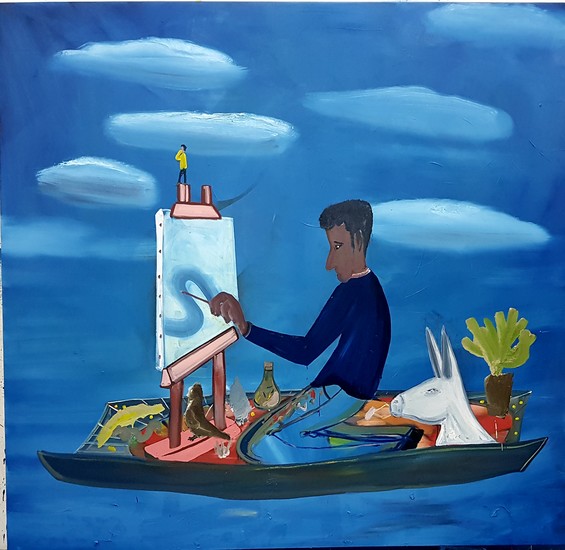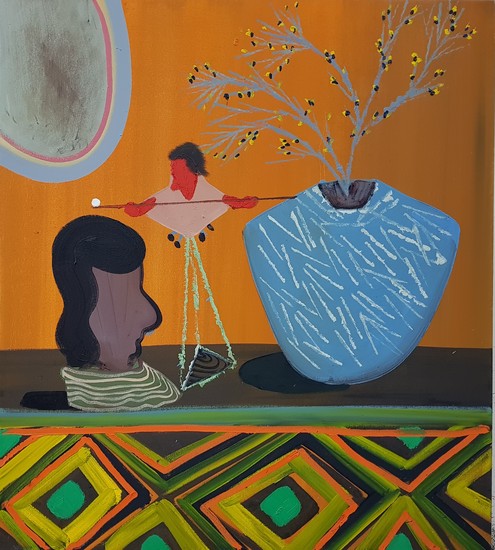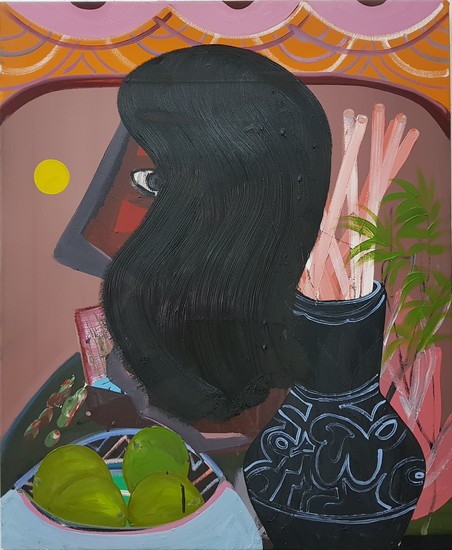Kitzur Shulchan Aruch
Shai Azoulay
From Casa Azul to Azoulay, from the Duties of the Heart to the wisdom of the hearts: The meeting of worlds in Shai Azoulay’s exhibition “Kitzur Shulchan Aruch”
Joseph Karo’s Shulchan Aruch (“set table”) is one of the most important books of Jewish law. Written in the 16th century, it shaped Jewish life for centuries. Published 300 years later, Kitzur Shulchan Aruch (“the summary of set table”) recapitulated Shulchan Aruch with a clear and approachable language, popularizing it in Jewish communities around the world. Shai Azoulay sets souls and daily lives over tabletops and other surfaces, amalgamating approachability and mystery. Tablecloths covered with rich still life present a spread of objects, food, and house plants coupled with living creatures, such as animals and human hands that extend into the painting and intervene in the table’s happenings. The artist’s figure can also be found in the paintings, pinned on the table as if representing “the self” on a board game. It is a puzzle of imagery. A Sephardic James Brown lookalike, the black-haired man wearing the seventies’ signature sideburns, is embedded in the artwork, mixing ars-poetica with the poetics of the Israeli “ars” (a derogatory term historically used to describe Sephardic men). As a backdrop to the set tables, with their various objects and figures, are the intense shades of sun and sunsets that hot countries produce as well as a spectrum of blues. This color pallet pops out even in paintings with dark backgrounds, such as “Koko Banana” in which a parrot absorbs a rainbow of colors, and a yellow ripe banana peeks from a bowl.
The set table is not still life in the traditional artistic sense of the term, just as it is not a true-to-text visual representation of the traditional Jewish code. Rather, Shai Azoulay draws on the history of art and on the history of the Jewish people to create a table infused with a new energy of freedom, exploration, quest, and questioning. Familiar tales are scattered on the table, ripe with symbolism and references. They invite the viewer to step in and reorganize, like a child at play, the plethora of imagery and interpretations on the game board. In “The Wisdom of the Hearts”, alluding perhaps to another masterpiece in Jewish philosophy, The Duties of the Heart, the use of riddle and game is especially evident, as it is laid on the table awaiting the viewer’s interpretation. In “Nest” the image of the self is analogized to a bird as it builds a nest between the branches. A man among birds, inseparable from creation, ascends to the treetops to build a nest, a home, a family. Man establishes a base, but one that is perilously positioned between heaven and earth. The painting depicts vision, elevation, a search for inspiration, the pursuit to reach the highest branches of the tree.
The table displays orange, yellow and turquoise pottery decorated with shapes and motifs, thin and gentle almond trees, plants that spill sensually like human hair, leaves spread like fans, donkeys, ponies, and canaries. The homestead of the orientalist desert. One side of the mirror reflects Israeli locality; the other side shows naïve Latin American artwork. The plants and cacti in Frida Kahlo’s garden in Casa Azul in Mexico City. Shai Azoulay’s wild botanic habitat is more similar to Casa Azul than it is to Claude Monet’s
house garden in Giverny, France. The color blue, “azul”, is hidden in the surname of Azoulay, a descendent of Moroccan goldsmiths who set gemstones, sapphire and turquoise between silver threads. In her self-portraits, Frida Kahlo’s face and black hair are framed with thick and vivid green tropical leaves that camouflage a green butterfly, and a parrot rests on her shoulder. In Shai Azoulay’s “Story, Selfie” the black-haired figure lays under a giant cactus planted in a turquoise pot. The cactus flowers peak between the thick leaves like the fuzzy balls on a clown’s hat. The painting is whimsical and joyful. Both Kahlo and Azoulay present the vegetation endemic to warm countries as backgrounds to their self-portraits, signaling how one takes roots in a homeland. Kahlo’s self-portrait was created in the 1940s. In 2019, the artist’s cell phone captures a “selfie” and a “story” of black hair set against desert plants.
In the painting “Mid-Career”, the table is set on the artist’s back, and the tablecloth spread across it is a scarlet sack of tales, full of cacti, various plants, row boats sailing the sea, an orange pineapple, and a golden anchor. All this dense internal world of desires and burning questions sticks atop the body of the black-haired man like the snail that carries his shell. The artist’s limbs are the dynamic legs of a table, meandering between glasses of paintbrushes and color threads. The image of Joseph and his coat of many colors is clearer and enigmatic than ever, as he hallucinates glorious dreams of set tables.




